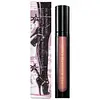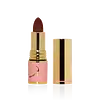Pat McGrath Labs Liquilust Legendary Wear Lipstick Versus Dafna Beauty Vintage Long-Lasting Matte Lipstick
What's inside
What's inside
 Key Ingredients
Key Ingredients

 Benefits
Benefits

 Concerns
Concerns

 Ingredients Side-by-side
Ingredients Side-by-side

Isododecane
EmollientTrimethylsiloxysilicate
EmollientCyclopentasiloxane
EmollientDimethicone
EmollientDiisostearyl Malate
EmollientKaolin
AbrasiveSynthetic Beeswax
Emulsion StabilisingVinyl Dimethicone/Methicone Silsesquioxane Crosspolymer
Silica Dimethyl Silylate
EmollientDisteardimonium Hectorite
StabilisingDimethicone Crosspolymer
Emulsion StabilisingPropylene Carbonate
SolventEthylhexyl Methoxycinnamate
UV AbsorberTocopheryl Acetate
AntioxidantPhenoxyethanol
PreservativeCI 77891
Cosmetic ColorantCI 45410
Cosmetic ColorantIron Oxides
CI 15850
Cosmetic ColorantCI 19140
Cosmetic ColorantCI 42090
Cosmetic ColorantCI 77742
Cosmetic ColorantCI 73360
Cosmetic ColorantIsododecane, Trimethylsiloxysilicate, Cyclopentasiloxane, Dimethicone, Diisostearyl Malate, Kaolin, Synthetic Beeswax, Vinyl Dimethicone/Methicone Silsesquioxane Crosspolymer, Silica Dimethyl Silylate, Disteardimonium Hectorite, Dimethicone Crosspolymer, Propylene Carbonate, Ethylhexyl Methoxycinnamate, Tocopheryl Acetate, Phenoxyethanol, CI 77891, CI 45410, Iron Oxides, CI 15850, CI 19140, CI 42090, CI 77742, CI 73360
Cyclopentasiloxane
EmollientCI 15850
Cosmetic ColorantTrimethylsiloxysilicate
EmollientCI 15985
Cosmetic ColorantCI 77891
Cosmetic ColorantSynthetic Beeswax
Emulsion StabilisingKaolin
AbrasiveMica
Cosmetic ColorantTitanium Dioxide
Cosmetic ColorantSilica
AbrasiveDimethicone
EmollientCI 77007
Cosmetic ColorantCI 77742
Cosmetic ColorantBHA
AntioxidantTocopheryl Acetate
AntioxidantCI 77491
Cosmetic ColorantButyrospermum Parkii Butter
Skin ConditioningWater
Skin ConditioningPrunus Amygdalus Dulcis Oil
Skin ConditioningButyl Acrylate/Hydroxypropyl Dimethicone Acrylate Copolymer
PEG-8 Caprylic/Capric Glycerides
EmulsifyingPolymethylsilsesquioxane
CI 77492
Cosmetic ColorantCI 45380
Cosmetic ColorantCI 77499
Cosmetic ColorantMethylparaben
PreservativeEthylparaben
PreservativePhenoxyethanol
PreservativePropylparaben
PreservativeOctyldodeceth-25
CleansingSodium Hyaluronate
HumectantPropylene Glycol
HumectantDecylene Glycol
Skin ConditioningCyclopentasiloxane, CI 15850, Trimethylsiloxysilicate, CI 15985, CI 77891, Synthetic Beeswax, Kaolin, Mica, Titanium Dioxide, Silica, Dimethicone, CI 77007, CI 77742, BHA, Tocopheryl Acetate, CI 77491, Butyrospermum Parkii Butter, Water, Prunus Amygdalus Dulcis Oil, Butyl Acrylate/Hydroxypropyl Dimethicone Acrylate Copolymer, PEG-8 Caprylic/Capric Glycerides, Polymethylsilsesquioxane, CI 77492, CI 45380, CI 77499, Methylparaben, Ethylparaben, Phenoxyethanol, Propylparaben, Octyldodeceth-25, Sodium Hyaluronate, Propylene Glycol, Decylene Glycol
Ingredients Explained
These ingredients are found in both products.
Ingredients higher up in an ingredient list are typically present in a larger amount.
Ci 15850 is the pigment color red. It is an azo dye and created synthetically.
Azo dyes need to be thoroughly purified before use. This allows them to be more stable and longer-lasting.
This ingredient is common in foundations, lipsticks, and blushes. This color is described as brown/orangey red.
It has many secondary names such as Red 6 and Red 7. According to a manufacturer, Red 6 usually contains aluminum.
Learn more about CI 15850This ingredient is used to add a violet color to cosmetics.
It is created by reacting phosphoric acid, ammonium dihydrogen orthophosphate, and manganese dioxide.
Ci 77891 is a white pigment from Titanium dioxide. It is naturally found in minerals such as rutile and ilmenite.
It's main function is to add a white color to cosmetics. It can also be mixed with other colors to create different shades.
Ci 77891 is commonly found in sunscreens due to its ability to block UV rays.
Learn more about CI 77891Cyclopentasiloxane, or D5, is a silicone used to improve texture of products and trap moisture.
D5 is considered lightweight and volatile. Volatile means it evaporates quickly after application. Once evaporated, D5 leaves a thin barrier that helps keep skin hydrated.
It is also an emollient. Emollients help soften the skin and prevent water loss. Silicones create a silky texture in products. D5 helps other ingredients become more spreadable.
Studies show D5 is safe to use in skincare products. We recommend speaking with a skincare professional if you have concerns.
Learn more about CyclopentasiloxaneDimethicone is a type of synthetic silicone created from natural materials such as quartz.
What it does:
Dimethicone comes in different viscosities:
Depending on the viscosity, dimethicone has different properties.
Ingredients lists don't always show which type is used, so we recommend reaching out to the brand if you have questions about the viscosity.
This ingredient is unlikely to cause irritation because it does not get absorbed into skin. However, people with silicone allergies should be careful about using this ingredient.
Note: Dimethicone may contribute to pilling. This is because it is not oil or water soluble, so pilling may occur when layered with products. When mixed with heavy oils in a formula, the outcome is also quite greasy.
Learn more about DimethiconeKaolin is a clay. It is used for oil control and to help minimize pores. Like other clays, kaolin has the ability to absorb excess sebum or oil. This can help clean out pores and mattify the skin.
Some types of kaolin may have exfoliating properties. When water is added to kaolin, it becomes a paste with small abrasive particles.
Most kaolin is a white color, but may be pink/orange/red depending on where it comes from.
The name 'kaolin' comes from a Chinese village named 'Gaoling'. Kaolin clay comes from rocks rich in kaolinite. Kaolinite, the mineral, has a silicate layered structure. Kaolinite is formed from chemical weathering of aluminum siilicate minerals.
Besides skincare, kaolin is commonly used to make glossy paper, in ceramics, toothpaste, and as medicine to soothe stomach issues.
Learn more about KaolinPhenoxyethanol is a preservative that has germicide, antimicrobial, and aromatic properties. Studies show that phenoxyethanol can prevent microbial growth. By itself, it has a scent that is similar to that of a rose.
It's often used in formulations along with Caprylyl Glycol to preserve the shelf life of products.
Synthetic beeswax is created to be identical in structure to beeswax. It possesses the same occlusive and emulsion properties.
A blend of fatty acid esters, fatty acids, and alcohols are used to create synthetic beeswax. Whether or not this ingredient is vegan depends on the source. Sometimes, lanolin is used for its creation.
This ingredient may not be Malassezia folliculitis, or fungal-acne safe.
Learn more about Synthetic BeeswaxTocopheryl Acetate is AKA Vitamin E. It is an antioxidant and protects your skin from free radicals. Free radicals damage the skin by breaking down collagen.
One study found using Tocopheryl Acetate with Vitamin C decreased the number of sunburned cells.
Tocopheryl Acetate is commonly found in both skincare and dietary supplements.
Learn more about Tocopheryl AcetateThis silicone is an emollient. Emollients create a thin film on the skin to prevent moisture from escaping.
It is not soluble in water and helps increase water-resistance in products.
According to a manufacturer, it can blend seamlessly with silicone oils, such as Cyclopentasiloxane.
Learn more about Trimethylsiloxysilicate